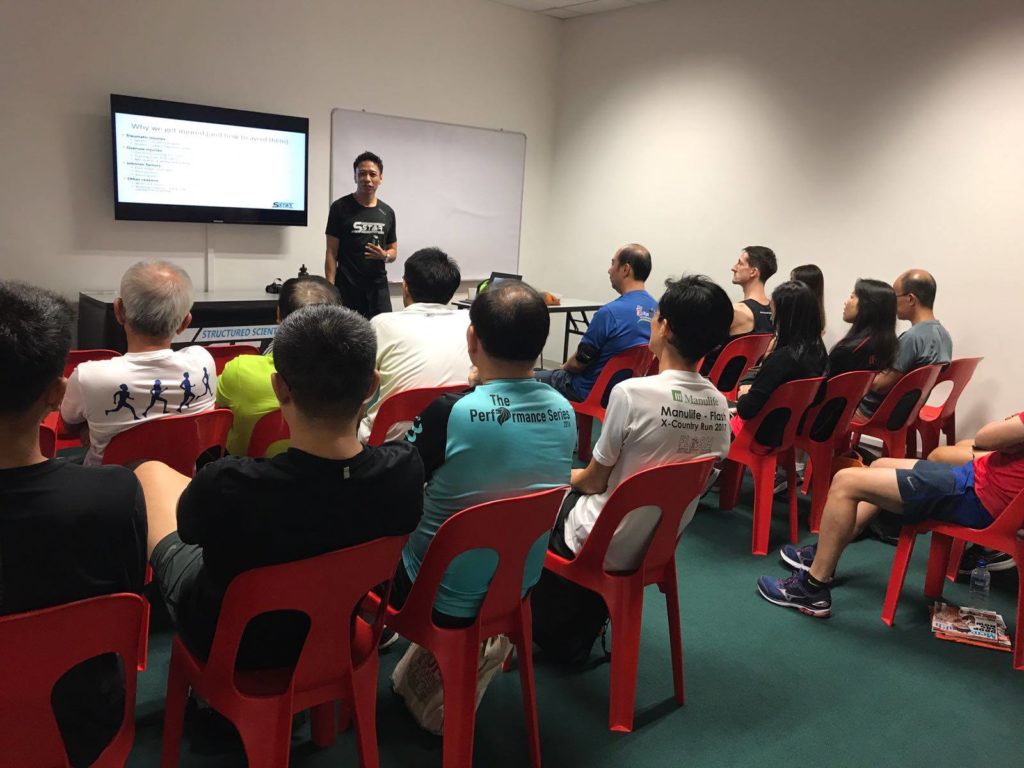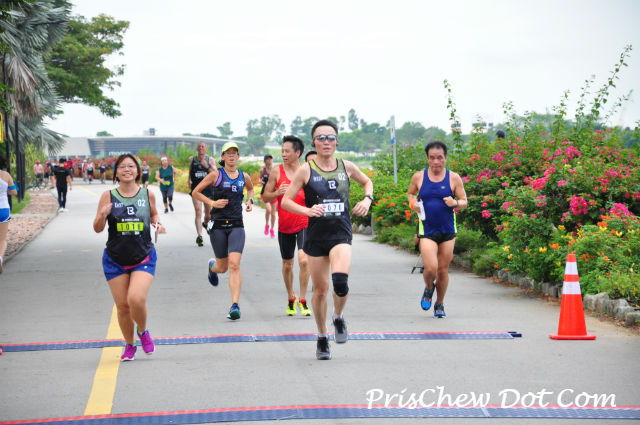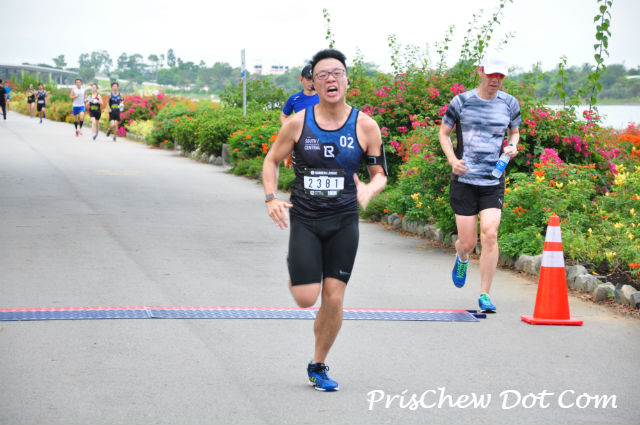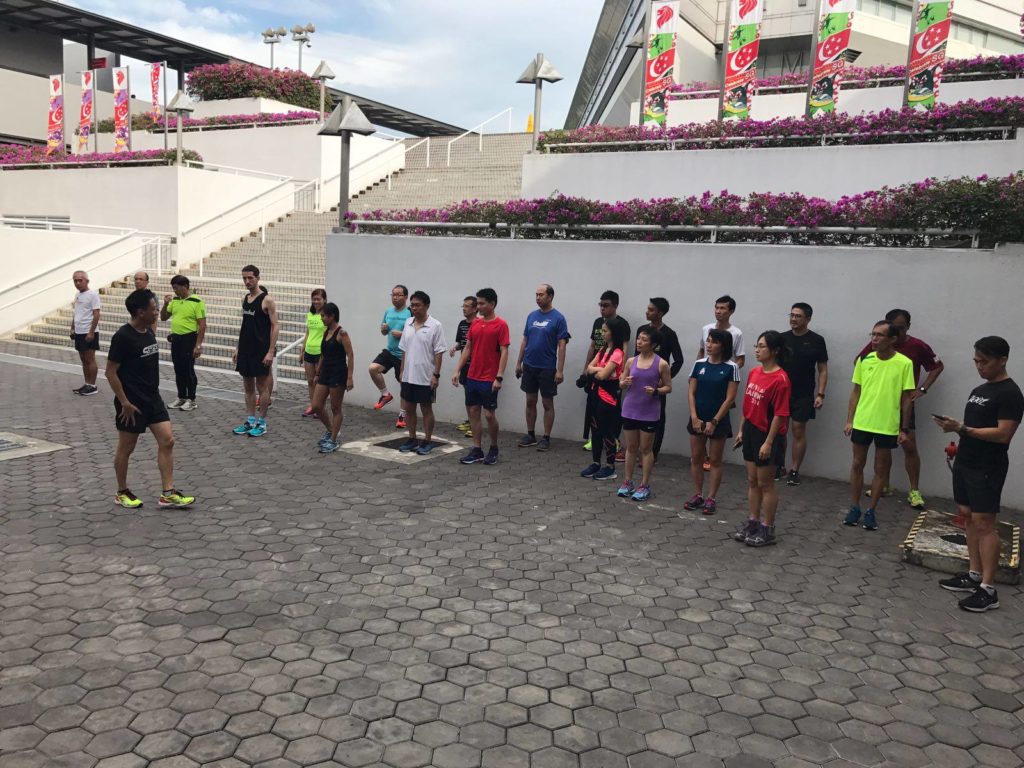To prepare runners for the CSC Run by the Bay, taking place on 1 October this year, Head Coach Andrew Cheong from SSTAR.FITNESS held a running workshop last weekend at the Sports Hub Library, about injury prevention, pre-race preparations and training smart.
Founded in 2016, SSTAR.FITNESS offers customised training programmes for athletes of all abilities ranging from 5km races to marathons as well as ultra marathons and triathlons.

Andrew Cheong from SSTAR.FITNESS gave a talk to prepare runners for CSC Run by the Bay.
Coach Andrew himself has been running since the 1980s, having completed more than 30 marathons and triathlons and has also completed all six World Marathon Majors. Andrew is also a Certified RRCA Distance running coach, FISAF certified Personal Trainer, IAAF Track and Field Coach, as well as being a certified Mental Toughness Institute (USA) coach.
What happens when a runner is injured?
According to Andrew, runners will lose their speed and endurance when they sustain an injury and they are thus unable to train. This also happens when a runner decides to take a complete break from training perhaps during the off-season – for example, student athletes who choose to hang up their running shoes for three or four months so that they can concentrate on studying for their end-year exams.
But do you lose your speed or your endurance more rapidly?
Said Andrew, “Interestingly, you lose endurance quicker. You can keep your speed for a longer time. That is what the science says. So if you stop training for six weeks, it is not speed, but endurance that disappears quicker.”

Andrew asks, “Do you lose speed or endurance first?”
He added, “However, the old marathon training programmes focus on base building and incorporating long runs first, then only after which you focus on speed as race day comes closer. Instead we should plan our training according to periodised training cycles and continuously balance speed and long runs within each cycle. The latest training programmes that we provide have long runs all the way till four weeks before race day, as it has been proven that endurance related fitness is not lost.”
But with age, Andrew pointed out that strength training also becomes important. He said, “By age 65 without exercise, you could lose up to 80 per cent of your muscular strength. A lot of distance runners neglect strength training; they need to do more of this if they want to keep running as they grow older.”
Why runners get injured
According to Andrew, runners get injured due to a few different reasons. Some of these are as follows.
Trauma
Trauma is not a common cause of injury amongst runners, and this typically manifests in the form of sprains and strains from running related accidents. For example, when runners trip, fall and lose their balance, they can sprain their ankle, one of the most common traumatic injuries.
Overuse
Overuse injuries are more common – it usually happens when runners pile on the training load too soon.
Said Andrew, “If you do too much and you don’t recover from training, over a long term you could over-train and fail to reach your full potential.”

Runners may get injured when they pile on too much mileage too soon.
But Andrew however, pointed out that the 10 per cent rule to increase weekly running mileage is not a hard and fast rule, and that it is not proven by science. Rather, it is an arbitrary figure that seems safe and convenient for most people.
Instead there are other ways for mileage progression, for example, to increase your weekly mileage for three weeks and then bring it down on the fourth week, before increasing it in the next cycle.
Mismatch of ability
Having a mismatch of sports ability can also lead to injuries. For example, runners run in a linear direction and their sport does not require much lateral movements. So if a runner decides to try squash occasionally, overdoing it would increase the chance of injury because of the lateral movements required in squash is not something that the runner would be used to.

Running is a very linear type of sport.
Cambered surfaces
According to Andrew, running on cambered surfaces can also increase injury risk.
These are surfaces whereby one side is higher than the other., so your hips are not level when you are running. This imbalance may result in injury as one side of the body is not alligned.
Wrong Running Shoes
Andrew also reiterated that choosing the right running shoes are important depending on the structure and the shape of your feet. For example, runners with naturally high arches will require shoes with more cushioning in the heel and forefoot. Runners with low or weak arches need motion control shoes.
Runners should also not wear worn-out running shoes for their runs as the midsole would have lost their cushioning properties or the adhesives that hold the shoe together would have deteriorated.
This also applies to new running shoes that have been kept in the cupboard for years before they are taken out, and also heavily discounted shoes from warehouse sales, as you don’t know how long the shoes have been kept in cold storage for, the glue that kept the shoe lining together could have dried our before you put them on your feet.
Reduce Injuries
In order to reduce your risk of injuries, Andrew suggested that runners should do a dynamic warm up, as well as choosing the right running shoes.
Rest is also important to Andrew and he strongly recommended runners to get adequate amount of sleep per night too as this will help to promote recovery and healing after training.

Andrew brings us through some running drills.
Cross training, according to Andrew, is also great in terms of correcting muscle imbalances and in turn, reducing the risk of overuse injuries. Yet at the same time because you are exercising, you can still maintain your aerobic fitness levels.
Running Drills
Andrew also suggested that runners do drills. Together with a strong set of core muscles, it will help runners maintain good running form..
What are running drills? They typically focus on one or more aspects of good running form and reinforce them with repetitive motion, with the aim of teaching the body to be able to consistently repeat that motion and incorporate it into the person’s normal running form.
Andrew took us through a few different types of running drills.
He first had us stand upright against a wall and look straight ahead, keeping the pelvis parallel to the ground, spine straight, shoulders level and head centred. Andrew used this to gauge whether we had good posture in terms of our head position, shoulders and hips.
After that we were brought outside to practise falling forward. According to Andrew, this enables you to use gravity to help you when you run, rather than fighting against gravity. As such, it enables you to run more efficiently. As well, falling forward involved keeping the correct posture and then leaning from the ankles not at the waist, shifting one’s centre of mass in front of your body.

Drills are good to develop positive running habits, says Andrew.
We practised both against a wall as well as with a partner; the aim of the second exercise was that our partner could gauge whether we were doing the exercise correctly. If we could feel his or her weight, then we were falling forwards correctly.
After that, we then practised doing ankle lifts. According to Andrew, ankle lifts are more recommended over knee lifts for long distance running. This is because ankle lifts make use of the large leg muscles such as the glutes and hamstrings, which would make running over long distances more efficient. But on the other hand, doing knee lifts use small muscles in the hip to return the leg back to the starting position, that would be more suited to power sprinters than marathoners.
SMART Goals
After the drills, Andrewg brought us back into the Sports Hub Library, where he then explained to us about the five SMART principles of training.
These are as follows.
- Specific – Set a specific running goal and you will have a specific result. For example, ‘to run a four-hour marathon by the end of the year’ versus ‘to run my personal best.’
- Measurable – Set goals that can be measured, instead of goal like ‘I want to get fitter’. Then you will need to find a way to measure ‘fitter’.
- Attainable – Ask yourself whether the goal is realistic. For example, if your current marathon personal best stands at 5 hours, is it really realistic to target a Boston qualifier by the end of the year?
- Relevant – Set goals that are relevant to you in terms of your achieving your dreams and aspirations.
- Time – Give yourself a fixed time frame so that you can stay accountable in terms of making your goals.

Andrew also recommends runners to follow a concrete training programme.
Follow a structured training programme
As well, Andrew also recommended runners to follow a structured training programme in order to continue to stay focused with their training.
However Andrew also reiterated that the training programme ideally should be customised to each runner, depending on his or her strengths, weaknesses and race goals. Said Andrew, “If the whole group of runners does the same workout, then something is missing. Everyone is defferent, even if the whole team is training for the same race. Our differences come from our age, genes, metabolism and mental strength.”
He continued, “For example, runners with with Type 2 muscles have more explosive power and are more suited to shorter, faster distances. But others with more Type 1 muscles cannot go as fast, yet they have the endurance to last long distances – these runners are suited to the marathon. So it’s useful to match your muscle type with a customised training programme that takes into account your specific strengths and weaknesses.”
For instance, SSTAR.FITNESS has customised training programmes that are varied and designed to give runners a variety of both hard and easy training variations. Sessions typically consist of tempo runs to improve running economy at Lactate Threshold, long runs to improve aerobic stamina, as well as speed to improve VO2Max and cross training.
Said Andrew, “We believe in the hard and easy training concept. Hard training means to overload so that the body can respond and grow stronger. Easy training sessions are to help the body to recover and bring fitness to a higher level.”

We all learnt a lot from Andrew during the session.
He continued, “The body will adapt and you will get stronger. As you start training, the body needs time to adjust to the training so your fitness will drop slightly at first. For example if you do chin-ups on one day, you might not be able to lift your arms the next day. But the body gets used to it, and you will eventually grow stronger and get used to doing chin-ups.”
But in order to get to the next level, Andrew added that you cannot keep on doing the same thing day in and day out.
He explained, “You need to vary your workouts otherwise the body cannot improve. This can be achieved when you introduce changes in frequency of workouts. intensity, e.g. faster speed for running uphill, time spent in training and type of training. These variations are also widely known as the FITT principle. With each change, the body will then have to adapt, recover and adapt again. The art and science of a good training programme is to know when to and how much to increase. If done correctly, this process will result in a smooth progression of fitness improvement.”

Leave a Comment